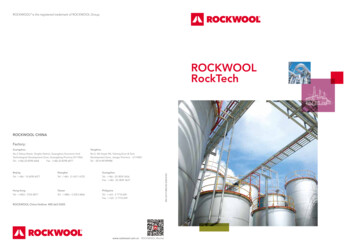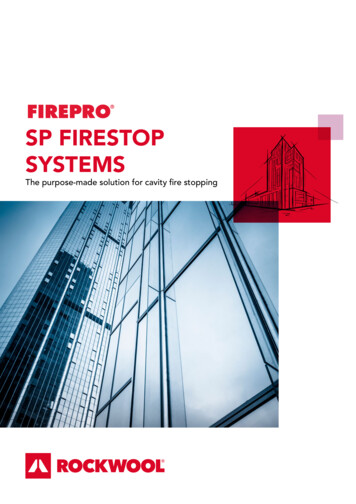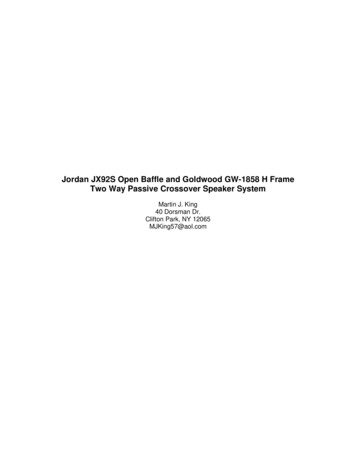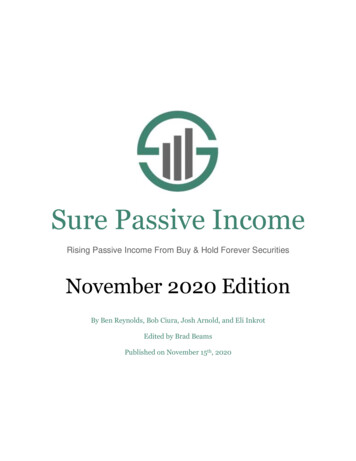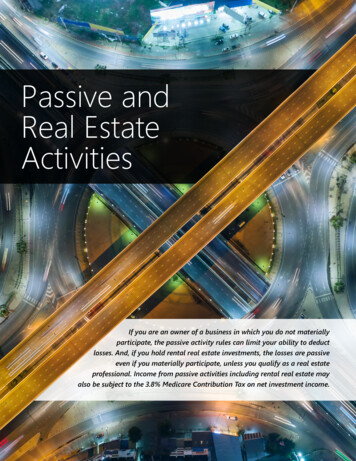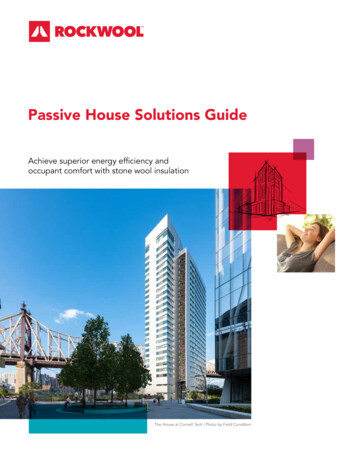
Transcription
Passive House Solutions GuideAchieve superior energy efficiency andoccupant comfort with stone wool insulationThe House at Cornell Tech Photo by Field Condition
IntroductionPassive House is a voluntary standard for buildingswhere the primary goals are to achieve superiorenergy efficiency and occupant comfort. It is anenclosure first “passive” approach that encompassesall aspects of high energy performance, sustainabilityand resiliency that can be applied to all types ofbuildings, in all types of climates.In North America Passive House Requirements are set out bytwo organizations:1. International Passive House Institute (PHI) in affiliation with NA PassiveHouse Network (NAPHN)2. Passive House Institute US Inc (PHIUS) in affiliation with Passive HouseAlliance US (PHAUS)ROCKWOOL has two wall enclosure systems certified by PHI: Mass Wall andSteel Frame Wall. The system and details, as outlined in this guide, can bedirectly incorporated into your project.For further assistance with your Passive House project,visit www.rockwool.com/passivehouseA Passive House is a building,for which thermal comfort(ISO 7730) can be achievedsolely by post-heating orpost-cooling of the fresh airmass, which is required toachieve sufficient indoor airquality conditions – withoutthe need for additionalrecirculation of air.- Passive House InstituteDisclaimer: ROCKWOOL has exercised due care to ensure that the data and information contained in thisdocument is accurate. However, this document is intended for general reference only. While the specificenclosure systems and details have been certified by Passive House Institute, actual results may vary dependingon a number of independent factors specific to the given end-use application including, but not limited to,design, workmanship, materials, geographic, environmental, and other specific or unique end use conditions.The end-use application is a determination that must be made independently by the architects, engineerand/or consultant in their own professional judgement. ROCKWOOL fully disclaims any liability for any of thecontent contained herein whether such liability be premised on a theory of contract, tort, or otherwise.ROCKWOOL2
Why Passive House?Energy EfficiencyEnergy efficiency is the primary goal for Passive House. Taking a buildingenclosure first approach, the high R-value requirements reduce the energydemand of buildings up to 90% in comparison to existing buildings and70% in comparison to typical new constructions. The low energy demandof Passive House designs promote the use of passive solar heating anddaylighting as well as smaller mechanical systems which further increasesthe energy efficiency of a building. Consequently, in comparison to typicalbuildings where heating and cooling energy is dominant, the energyconsumption to power electricity and the total embodied energy of theconstruction materials used in Passive House buildings becomes moresignificant.Occupant ComfortPassive House buildings are often described as quiet and comfortable. Withmost of our day spent indoors, occupant comfort is a critical considerationwhen designing for high performance. The high performance enclosure incombination with stringent demands for mitigating thermal bridging and airleakage increases interior surface temperatures while reducing the risk ofcold draughts and potential for condensation that can lead to poor indoorair quality and occupant comfort. Furthermore, a highly insulated buildingenclosure helps to improve indoor acoustics creating a productive workenvironment and a healthy home.Sustainable and ResilientThe Passive House standard is often adopted when aspiring to achieve netzero energy buildings. The low energy demands make it easier to incorporaterenewable energy sources. Additionally, in times of climate change andsevere weather occurrences, high thermal autonomy and resiliency inbuildings is critical. A high-performance building enclosure increases thethermal autonomy of a building where the building can passively maintaincomfortable conditions without the use of active systems.70-90%Reduction in EnergyDemands ofBuildings.ROCKWOOL3
Passive House PrinciplesPassive House is a voluntary performance based standard, governed by fivefundamental design principles, that promote the use of passive measures prior tothe incorporation of active systems.Highly Insulated WallsA highly insulated building enclosure is the keycomponent to achieving Passive House. With highR-value walls, considerations for moisture transportand drying potential as well as fire codes and life safetyis critical. The thickness and location of the thermalinsulation is dependent on the type of structure, withoptimal performance achieved when using all (or mostly)continuous exterior insulation (c.i.).High Performance WindowsWindows and doors are typical weak points withinthe thermal enclosure. The use of triple pane highperformance windows that are Passive House certifiedare required for compliance. Window to wall ratios arecalculated and determined based on the orientation,glazing type and shading mechanism to take maximumadvantage of passive solar daylight.Thermal Bridge FreeA thermal bridge is a localised area or component of thebuilding enclosure with a higher thermal conductivitythan the surrounding materials, creating a path for heattransfer. Thermal bridges result in an overall thermalresistance reduction leading to cold spots on the interiorside of the assembly and risks of condensation within theenclosure.There are three types of thermal bridges: repeated, linearand point thermal bridges.A repeated thermal bridge, is often found within thestructural component of the enclosure and is taken intoaccount in the overall U-Value calculation. For example,wood studs and/or steel studs.A linear thermal bridge, expressed as a Psi Value (Ψ),is found along the length of the enclosure occurringmainly at component joints, edges and transitions withinthe building enclosure. For example, a window to wallconnection or slab edge are considered linear thermalbridges. Linear thermal bridges are calculated separatelyusing 2D thermal modelling software.A point thermal bridge, expressed as a Chi Value (X),occurs at isolated points within the enclosure. Forexample, insulation attachments and/or fasteners. Pointthermal bridges are calculated separately using 3Dthermal modelling software.Along with thermal bridging calculations, thetemperature factor, FRsi 0.25m2K/W, must be met atthe weakest point at the interior side of the detail (i.e.the coldest point on the interior side).Airtight EnclosureA leaky building enclosure leads to excess heat transfer,cold spots and potential for condensation. To achieve acontinuous airtight enclosure, close attention to detail isrequired at all joints and penetrations. The airtightness ofa Passive House is measured by means of an air pressuretest of the building.Heat Recovery VentilationAppropriate mechanical and ventilation systems arecritical to ensure clean and fresh air intake and occupantcomfort. High performance energy recovery systems(ERV), required for Passive House, help reduce energylosses by taking advantage of heat energy fromextract air.ROCKWOOL4
Building Enclosure RequirementsPHI CertificationCriteria1. U-Value Recommendations:Opaque Wall and Roof U-Value 0.15 W/m²K(0.14 BTU/h·ft2· F)Fenestration (Triple-pane Windows) Ug-Value 0.80 W/m²K(0.14 BTU/h·ft2· F) and g-value: 0.5 - 0.62Space heating demand 15kWh/m²yr or Peak heating load 10 W/m²2. Thermal-bridge Free:Linear thermal bride Ψe 0.01 W/mKPoint Thermal Bridge X 0.005 W/m²KSpace cooling demand 15kWh/m²yr or excesstemperature frequency(T 25 C/77 F) 10%3. Airtightness 0.6 ACH @ 50PaPrimary energy demand 120kWh/m²yr or primary energyrenewable 60 kWh/m²yrAirtightness 0.6 ACH@50PaHeat RecoveryVentilationHighlyInsulated WallsHigh lBridge Free
Benefits of using Stone Wool InsulationROCKWOOLTM products meet the call for higher energyefficiency, sustainability, durability and better overallperformance in buildings.Continuous InsulationAbove-grade wall assembliescan be installed using either onlyexterior continuous insulation or incombination with interior insulationdepending on the construction type.For steel framed applications,ROCKWOOL COMFORTBATTstud wall cavity insulation can befriction fit between studs. Semi-rigidROCKWOOL CAVITYROCK and rigidROCKWOOL COMFORTBOARD 110continuous insulation boards forcavity walls and rainscreens are waterrepellent yet vapor permeable thatcan be installed on the exterior sideof a wall assembly for steel framedand mass wall types. TMHigh density ROCKWOOLTOPROCK DD and ROCKWOOLMULTIFIX can be installed in lowsloped roof application, above deck(concrete or steel), providing superioracoustic and fire performance. TMOptimal Thermal PerformanceA stable building enclosure candramatically reduce heating, cooling,and ventilation costs, and reducea building’s carbon footprint. TheR-value of ROCKWOOL insulation willnot change over time because stonewool is not produced with blowingagents, which can off-gas and resultin lower thermal performance. Notonly is the thermal performance ofstone wool insulation maintainedover its lifetime, but the wall’s thermalperformance remains consistentbecause stone wool products aredimensionally stable. ROCKWOOLinsulation will not expand or contractdue to temperature variances withinthe enclosure. These attributes resultin optimal thermal performance of abuilding envelope.Fire ResistanceWith Passive House requirementscalling for higher insulating valuesand the use of continuous insulation,designing with fire resistance andlife safety in mind is essential.ROCKWOOL stone wool insulationis extremely resilient to fire. Madeof non-combustible material, stonewool insulation has a melting point ofapproximately 1177 C (2150 F) andit works to contain fire and preventits spread. At the same time, it doesnot contribute to the emission ofsignificant quantities of toxic smokeeven when directly exposed to fire.This provides a critical line of defense,keeping occupants safe and reducingproperty damage in the event of afire.ROCKWOOL6
Vapor PermeabilityInsulation products, membranesand other building materialsall have varying levels of vaporpermeability and can potentially actas a vapor retarder. When designingenclosures with thick insulation levels,consideration with regards to theappropriate use of vapor retardersis critical. Depending on the climatelocation of the building, the vaporretarder profile should be either onthe interior or exterior side of theenclosure.For Passive House buildings, incombination with a vapor permeablewater resistive barrier membrane, theuse of ROCKWOOL vapor permeableexterior insulation allows forincreased potential for drying withouttrapping moisture in the assembly.Additionally, the use of transientvapor retarders on the interior side,also known as smart membranes”,enables drying potential to theinterior when necessary, furtherenhancing the durability of theenclosure.Acoustic Control and ComfortConsidering the acousticalperformance of every assembly onthe building envelope is critical whendesigning for a high performancesystem. Noise will travel throughthe weakest sections of the buildingenvelope, and the effectiveness of ahigh performing wall or roof systemmay be reduced when the rest of thebuilding is not equally designed for.When a component of wall and roofassemblies, ROCKWOOL stone woolinsulation can reduce external noisecreating a comfortable and healthyliving space. It’s the unique stonewool characteristics found within ourproducts that make them efficient atreducing noise.Efficient Cladding AttachmentSystemsThere are numerous generic andproprietary cladding support systemsdesigned for use with exteriorinsulation available in the markettoday. Many different materials areused to make these systems includinggalvanized steel, stainless steel,aluminium, fiberglass, and plastic.While each system is different,the approaches can generally beclassified as: continuous framing,intermittent clip and rail, longfasteners and masonry ties or otherengineered systems. Systems areavailable to accommodate a widerange of claddings for buildings ofall heights and exposures. Thermallyefficient cladding attachment systemsare critical for Passive House buildingsto mitigate thermal bridging.Links - For More Information Building Envelope AcousticSolutions Guide ROCKWOOL CladdingAttachment Guide Vapor Diffusion GuideROCKWOOL7
ROCKWOOL PH Certified Mass Wall - ID: 1274cs03 This enclosure system is concretemasonry unit (CMU) substrate using thefollowing vapor permeable stone woolproducts: ROCKWOOL CAVITYROCK ,ROCKWOOL COMFORTBOARD 110,ROCKWOOL TOPROCK DD andROCKWOOL MULTIFIXTMExternal WallThe exterior insulation on the walls is fastened usingthermally broken fibreglass clip system with stainless steelfasteners (or equivalent alternative).The primary airtight layer is a fully adhered vaporpermeable, air and water-resistive barrier, installed on theexterior side of the CMU. Depending on the climate zonerequirements, an optional interior vapor control layer canbe installed on the interior side and serve as a secondaryairtight layer if necessary.Installed R-Value 7.11 m2k/WEffective R-Value 7.14 m2k/WOverall U-Value0.140 W/m2k(40.40 ft2·hr·F /BTU)(40.56 ft2·hr·F /BTU)(0.024 BTU/ ft2·hr·F )Flat RoofDetail No.DescriptionPage No.FSEW01Floor Slab to Exterior Wall9FSIW01Floor Slab to Interior Load-bearing Wall10EWEC01Exterior Wall - Exterior Corner (plan)11EWIC01Exterior Wall - Interior Corner (plan)12EWIW01Exterior Wall to Interior Wall Junction(plan)13EWCE01Exterior Wall to Ceiling14FRRP01Flat Roof Parapet15WITH01Door Threshold16WIBO01Window Sill17WITO01Window Head18WISI01Window Jamb19Installed R-Value 6.02 m2k/WEffective R-Value 6.67 m2k/WOverall U-Value0.150 W/m2k(34.20 ft2·hr·F /BTU)(37.86 ft2·hr·F /BTU)(0.026 BTU/ ft2·hr·F )SlabInstalled R-Value 4.23 m2k/WEffective R-Value 4.46 m2k/WOverall U-Value0.224 W/m2kROCKWOOL8(24.00 ft2·hr·F /BTU)(25.35 ft2·hr·F /BTU)(0.039 BTU/ ft2·hr·F )
FSEW01 – Floor Slab to Exterior WallPsi 0.002 (W/mK) FRsi 0.93ROCKWOOL9
FSIW01 – Floor Slab to Interior Load-bearing WallPsi 0.009 (W/mK) FRsi 0.95ROCKWOOL10
EWEC01 – Exterior Wall - Exterior Corner (plan)Psi -0.058 (W/mK) FRsi 0.93ROCKWOOL11
EWIC01 – Exterior Wall – Interior Corner (plan)Psi 0.022 (W/mK) FRsi 0.97ROCKWOOL12
EWIW01 – Exterior Wall to Interior Wall Junction (plan)Psi 0.008 (W/mK) FRsi 0.94ROCKWOOL13
EWCE01 – Exterior Wall to CeilingPsi 0.010 (W/mK) FRsi 0.96ROCKWOOL14
FRRP01 – Flat Roof ParapetPsi -0.011(W/mK) FRsi 0.97ROCKWOOL15
WITH01 – Door ThresholdPsi 0.057 (W/mK) FRsi 0.71ROCKWOOL16
WIBO01 – Window SillPsi 0.027 (W/mK) FRsi 0.76ROCKWOOL17
WITO01 – Window HeadPsi 0.014 (W/mK) FRsi 0.76ROCKWOOL18
WISI01 – Window JambPsi 0.013 (W/mK) FRsi 0.76ROCKWOOL19
ROCKWOOL PH Certified Steel Frame Wall - ID: 1411cs03 This enclosure system is steel framesubstrate using the following vaporpermeable stone wool products:ROCKWOOL CAVITYROCK ,ROCKWOOL COMFORTBOARD 110,ROCKWOOL TOPROCK DD andROCKWOOL MULTIFIXTMEXTERIOR WALLExternal Wall4"(102 mm)4"4"(102 mm)(102 mm)16 3/4"(425 mm)4"6"(102mm)mm)(15216 3/4"(425 mm)6"(152 mm)13mm GYPSUM BOARD38mm SERVICE CAVITYDELTA Sd FLEXX (OPTIONALEXTERIOR WALL152mm ROCKWOOL COMFORT13mm EXTERIOR GYPSUM SH13mm GYPSUM BOARDDELTA-VENT SA (AIR BARRIE38mm SERVICE CAVITY200mm ROCKWOOL CAVITYRODELTA Sd FLEXX (OPTIONALEXTERIOR CLADDING (VARIES152mm ROCKWOOL COMFOR13mm EXTERIOR GYPSUM SHDELTA-VENT SA (AIR BARRI200mm ROCKWOOL CAVITYREXTERIOR CLADDING (VARIEThe exterior insulation on the walls is fastened usingthermally broken fibreglass clip system with stainless steelfasteners (or equivalent alternative).6"(152 mm)12"(305 mm)(58.40(43.68 ft2·hr·F /BTU)FLOOR FINISH(0.023 BTU/ ft2·hr·F )152mm CONCRETE SLAB152mm ROCKWOOL COMFORWATERTIGHT LAYER12"(305 mm)6"6"(152mm)mm)(152Installed R-Value 10.28 m2k/WEffective R-Value 7.69 m2k/WOverall U-Value0.130 W/m2kFLOOR FINISH152mm CONCRETE SLAB152mmROCKWOOL COMFORft2·hr·F /BTU)SLABWATERTIGHT LAYER6"(152 mm)The primary airtight layer is a fully adhered vaporpermeable, air and water-resistive barrier, installed onthe exterior side of the exterior sheathing. Depending onthe climate zone requirements, an optional interior vaporcontrol layer can be installed on the interior side andserve as a secondary airtight layer if necessary.SLAB22EWEC01Exterior Wall - Exterior Corner (plan)23EWIC01Exterior Wall - Interior Corner (plan)24EWIW01Exterior Wall to Interior Wall Junction(plan)25EWCE01Exterior Wall to Ceiling26FRRP01Flat Roof Parapet27WITH01Door Threshold28WIBO01Window Sill293"(76 mm)3"(76 mm)Floor Slab to Interior Load-bearing Wall3"(76 mm)FSIW0112"(305 mm)216"(152 mm)Floor Slab to Exterior WallROOFROOF MEMBRANE225mm ROCKWOOL TOPROCKDELTA-VENT SA (AIR BARRIEROOF13mm EXTERIOR GYPSUM SHSTEEL DECK (OVER STRUCTUROOF MEMBRANEINTERIOR FINISH (VARIES)225mm ROCKWOOL TOPROCDELTA-VENT SA (AIR BARRI13mm EXTERIOR GYPSUM SHEXTERIOR WALLSTEEL DECK (OVER STRUCTINTERIOR FINISH (VARIES)13mm GYPSUM BOARD38mm SERVICE CAVITYDELTA Sd FLEXX (OPTIONAL152mm ROCKWOOL COMFORT13mm EXTERIOR GYPSUM SHEDELTA-VENT SA (AIR BARRIE200mm ROCKWOOL CAVITYRO2ft ·hr·F /BTU)EXTERIOR CLADDING (VARIESInstalled R-Value 6.02 m2k/W(34.20(36.63 ft2·hr·F /BTU)Effective R-Value 6.45 m2k/W2k(0.027BTU/ ft2·hr·F ) UpdateOverall U-Value0.155 W/mPH CERTIFIEDSTEELFRAMEROCKWOOL 4"(102 mm)FSEW013"3"(76mm)mm)(76Page No.16 3/4"(425 mm)Description4"(102 mm)Detail No.12"(305 mm)3"(76 mm)Flat RoofROCKWOOL Slab PH CERTIFIED STEEL FRAMEWindow Head30WISI01Window Jamb316"(152 mm)12"(305 mm)6"(152 mm)WALLROCKWOOL203"(76 mm)3"(76 mm)12"(305 mm)3"(76 mm)WITO01June 2019Passive HouseAcademy (PHCertified ByPassive HouseInstitute (PHI)UpdateJune 2019Drawn ByPassive HousFor more information visitAcademy (PHwww.rockwool.com/passivehouseSLABCertified ByPassive HousInstitute (PHI)FLOOR FINISH152mm CONCRETE SLABFor more information visit152mmROCKWOOL COMFORTwww.rockwool.com/passivehouseWATERTIGHT LAYERDrawn ByWALLInstalled R-Value 4.23 m2k/WEffective R-Value 4.46 m2k/WOverall U-Value0.224 W/m2k(24.00 ft2·hr·F /BTU)(25.35 ft2·hr·F /BTU)(0.039 BTU/ ft2·hr·F )ROOFROOF MEMBRANE225mm ROCKWOOL TOPROCKDELTA-VENT SA (AIR BARRIE13mm EXTERIOR GYPSUM SHSTEEL DECK (OVER STRUCTUINTERIOR FINISH (VARIES)
FSEW01 – Floor Slab to Exterior WallPsi 0.003 (W/mK) FRsi 0.90TMROCKWOOL PH CERTIFIED STEEL FRAMEWALLUpdateDrawn ByCertified ByJune 2019Passive HouseAcademy (PHA)Passive HouseInstitute (PHI)For more information FSEW01FLOOR SLAB TOEXTERIOR WALLSheet No.2 of 12PHI IDScale1411cs031:10
FSIW01 – Floor Slab to Interior Load-bearing WallPsi 0.009 (W/mK) FRsi 0.96TM5"8PASSIVE HOUSE (CERTIFIED) DETAILSCOMMERCIAL - STEEL FRAMED1"126"1"125"8UpdateDrawn ByCertified ByROCKWOOL22June 2019Passive HouseAcademy (PHA)Passive HouseInstitute (PHI)DETAILFSIW01FLOOR SLAB TO INTERIORLOAD-BEARING WALLSheet No.3 of 12PHI ID1411cs03
EWEC01 – Exterior Wall - Exterior Corner (plan)Psi -0.056 (W/mK) FRsi 0.875"81"126"5"84"4"11"81"4PASSIVE HOUSE (CERTIFIED) DETAILSROCKWOOL23 UpdateDrawn ByJune 2019Passive HouseDETAILEWEC01
EWIC01 – Exterior Wall – Interior Corner (plan)Psi 0.020 (W/mK) FRsi 0.945"81"126"5"84"4"11"814"PASSIVE HOUSE (CERTIFIED) DETAILSCOMMERCIAL - STEEL FRAMEDUpdateROCKWOOL24 Drawn ByJune 2019Passive HouseAcademy (PHA)DETAILEWIC01EXTERIOR WALL - INTERIOR
EWIW01 – Exterior Wall to Interior Wall Junction (plan)Psi 0.003 (W/mK) FRsi 0.94ROCKWOOL25
EWCE01 – Exterior Wall to CeilingPsi 0.016 (W/mK) FRsi 0.965"8 112"PASSIVE HOUSE (CERTIFIED) DETAILSCOMMERCIAL - STEEL FRAMED6"5"84"UpdateDrawn By4"ROCKWOOL26Certified By11"8June 2019Passive HouseAcademy (PHA)Passive HouseInstitute (PHI)DETAILEWCE01EXTERIOR WALLTO CEILINGSheet No.7 of 12
FRRP01 – Flat Roof ParapetPsi 0.010 (W/mK) FRsi 0.882"5"8PASSIVE HOUSE (CERTIFIED) DETAILSCOMMERCIAL - STEEL FRAMED1"126"5"84"UpdateDrawn ByCertified ByROCKWOOL274"11"8June 2019Passive HouseAcademy (PHA)Passive HouseInstitute (PHI)For more information visitDETAILFRRP01FLAT ROOFPARAPETSheet No.8 of 12PHI ID1411cs03Scale1:10
WITH01 – Door ThresholdPsi 0.034 (W/mK) FRsi 0.70TMPASSIVE HOUSE (CERTIFIED) DETAILSCOMMERCIAL - STEEL FRAMEDUpdateDrawn ByCertified ByROCKWOOL28June 2018Passive HouseAcademy (PHA)Passive HouseInstitute (PHI)For more information visitDETAILWITH01DOOR THRESHOLDSheet No.9 of 12PHI IDScale1411cs031:10
WIBO01 – Window SillPsi 0.028 (W/mK) FRsi 0.765"8138"PASSIVE HOUSE (CERTIFIED) DETAILSCOMMERCIAL - STEEL FRAMED6"5"84"4"UpdateDrawn ByROCKWOOLCertified By29181"June 2019Passive HouseAcademy (PHA)Passive HouseInstitute (PHI)DETAILWIBO01WINDOW SILLSheet No.10 of 12PHI ID1411cs03
WITO01 – Window HeadPsi 0.014 (W/mK) FRsi 0.765"8 112"PASSIVE HOUSE (CERTIFIED) DETAILSCOMMERCIAL - STEEL FRAMED6"5"84"ROCKWOOLUpdate304"Drawn By1"18June 2019Passive HouseDETAILWITO01WINDOW HEAD
WISI01 – Window JambPsi 0.013 (W/mK) FRsi 0.765"8112"6"5"84"4"1"1814"PASSIVE HOUSE (CERTIFIED) DETAILSCOMMERCIAL - STEEL FRAMEDROCKWOOLUpdate31 Drawn ByJune 2019Passive HouseAcademy (PHA)DETAILWISI01WINDOW SILL
At the ROCKWOOL Group, we arecommitted to enriching the lives ofeveryone who comes into contactwith our solutions. Our expertiseis perfectly suited to tackle many oftoday’s bi ggest sustainability anddevelopment challenges, from energyconsumption and noise pollutionto fire resilience, water scarcity andflooding. Our range of productsreflects the diversity of the world’sneeds, while supporting ourstakeholders in reducing their owncarbon footprint.Stone wool is a versatile material andforms the basis of all our businesses.With more than 11,000 employeesin 39 countries, we are the worldleader in stone wool solutions,from building insulation to acousticceilings, external cladding systemsto horticultural solutions, engineeredfibres for industrial use to insulationfor the process industry and marineand offshore.AFB , CAVITYROCK ,COMFORTBATT , CONROCK ,CURTAINROCK , ROCKBOARD ,TOPROCK , MONOBOARD , ROXULare registered trademarks of theROCKWOOL Group in USA andROXUL Inc. in Canada. ROCKWOOL , COMFORTBOARD ,FABROCK , ROXUL SAFE ,ROCKWOOL PLUS , and AFB evoare trademarks of the ROCKWOOLGroup in USA and ROXUL Inc. inCanada. SAFE’n’SOUND is a registeredtrademark used under license. Publication date - edition: 06/2018 ROCKWOOL8024 Esquesing LineMilton, ON L9T 6W3Tel: 1 800 265 6878rockwool.com
2. Passive House Institute US Inc (PHIUS) in affiliation with Passive House Alliance US (PHAUS) ROCKWOOL has two wall enclosure systems certified by PHI: Mass Wall and Steel Frame Wall. The system and details, as outlined in this guide, can be directly incorporated into your project. For further assistance with your Passive House project,
